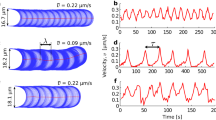Abstract
InLarix pollen captured by the ovule and rested at the distal end of the micropylar canal is transferred upward to the nucellus before it develops a pollen tube. This upward movement occurs after the canal is filled with secreted fluid, despite the fact that the pollen sinks in the fluid. We examined the mechanism of the movement based on the morphology of the canal and its simulation using pipettes. When a water column moves upward in a waxed pipette, suspended particles also move upward carried by the meniscus. InL. x eurolepis the inner surface of the integument lining the micropylar canal is coated by a cuticle layer. This layer is further coated by an integumentary membrane before the fluid is secreted. This membrane, however, becomes distorted or disappears during fluid secretion. The exposed cuticle and the degenerated hydrophilic nucellar apex may facilitate the movement of the meniscus toward the nucellus as in the simulated pipette. Pollen is interpreted to move by being carried by the meniscus when the fluid recedes.
Similar content being viewed by others
References
Barner, H. andChristiansen, H. 1960. The formation of pollen, the pollination mechanism, and the determination of the most favourable time for controlled pollinations inLarix. Silvae Genet.9: 1–11.
Doyle, J. 1926. The ovule ofLarix andPseudotsuga. Proc. Roy. Irish Acad., B37: 170–180.
Doyle, J. 1945. Developmental lines in pollination mechanisms in the Coniferales. Sci. Proc. Roy. Dublin Soc.24: 43–62.
Doyle, J. andO'Leary, M. 1935. Pollination inTsuga, Cedrus, Pseudotsuga, andLarix. Sci. Proc. Roy. Dublin Soc.21: 191–204.
Géléznoff, N. 1849. Sur l'embryologie du mélèze. Bull. Soc. Imp. Naturalistes Moscou22: 566–605.
Goebel, K. 1923. Organographie der Pflanzen, Teil 3. 2. Aufl. Gustav Fischer, Jena.
Hallam, N.D. 1982. Fine structure of the leaf cuticle and the origin of leaf waxes.In D.F. Cutler, K.L. Alvin and C.E. Price, eds., The Plant Cuticle, Academic Press, London, pp. 197–214.
Hayat, M.A. 1972. Basic Electron Microscopy Techniques. Van Nostrand Reinhold, New York.
Lill, B.S. andSweet, G.B. 1977. Pollination inPinus radiata. New Zealand J. For. Sci.7: 21–34.
Owens, J.N. andMolder, M. 1979. Sexual reproduction ofLarix occidentalis. Can. J. Bot.57: 2673–2690.
Owens, J.N., Morris, S.J. andCatalano, G.L. 1994. How the pollination mechanism and prezygotic and postzygotic events affect seed production inLarix occidentalis. Can. J. For. Res.24: 917–927.
Powell, G.R. andTosh, K.J. 1991. The pollination mechanism and development after bud burst of cones ofLarix laricina. Can. J. Bot.69: 1179–1187.
Runions, C.J. andOwens, J.N. 1996. Pollen scavenging and rain involvement in the pollination mechanism of interior spruce. Can. J. Bot.74: 115–124.
Said, C., Villar, M. andZandonella, P. 1991. Ovule receptivity and pollen viability in Japanese larch (Larix leptolepis Gord.). Silvae Genet.40: 1–6.
Sato, T. 1968. A modified method for lead staining of thin sections (in Japanese). J. Electron Microsc.17: 158–159.
Singh, H. 1978. Embryology of Gymnosperms. Gebrüder Borntraeger, Berlin.
Spurr, A.R. 1969. A low-viscosity epoxy resin embedding medium for electron microscopy. J. Ultrastruct. Res.26: 31–43.
Takaso, T. andOwens, J.N. 1995. Ovulate cone morphology and pollination inPseudotsuga andCedrus. Int. J. Pl. Sci.156: 630–639.
Takaso, T. andOwens, J.N. 1996a. Postpollination-prezygotic ovular secretions into the micropylar canal inPseudotsuga menziesii (Pinaceae). J. Plant Res.109: 147–160.
Takaso, T. andOwens, J.N. 1996b. Ovulate cone, pollination drop, and pollen capture inSequoiadendron (Taxodiaceae). Amer. J. Bot.83: 1175–1180.
Takaso, T., von Aderkas, P. andOwens, J.N. 1996. Prefertilization events in ovules ofPseudotsuga: ovular secretion and its influence on pollen tubes. Can. J. Bot.74: 1214–1219.
Tison, A. 1911. Remarques sur les gouttelettes collectrices des ovules des Conifères. Mém. Soc. Linn. Normandie24: 51–64.
Tomlinson, P.B. 1991. Pollen scavenging. Natl. Georg. Res. Expl.7: 188–195.
Tomlinson, P.B. 1994. Functional morphology of saccate pollen in conifers with special reference to Podocarpaceae. Int. J. Pl. Sci.155: 699–715.
Tomlinson, P.B., Braggins, J.E. andRattenbury, J.A. 1991. Pollination drop in relation to cone morphology in Podocarpaceae: a novel reproductive mechanism. Amer. J. Bot.78: 1289–1303.
Villar, M., Knox, R.B. andDumas, C. 1984. Effective pollination period and nature of pollen-collecting apparatus in the gymnosperm,Larix leptolepis. Ann. Bot.53: 279–284.
Author information
Authors and Affiliations
Rights and permissions
About this article
Cite this article
Takaso, T., Owens, J.N. Pollen movement in the micropylar canal ofLarix and its simulation. J. Plant Res. 110, 259–264 (1997). https://doi.org/10.1007/BF02509314
Received:
Accepted:
Issue Date:
DOI: https://doi.org/10.1007/BF02509314




